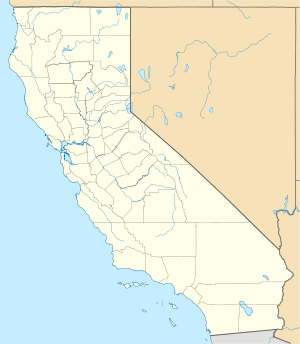Oxnard AFB
| Oxnard Air Force Base | |
|---|---|
| Part of Air Defense Command | |
| Camarillo, California | |

Convair F-106A-90-CO Delta Dart 57-2486 437th Fighter-Interceptor Squadron.
|
|
| Coordinates | 34°12′50″N 119°05′40″W / 34.21389°N 119.09444°WCoordinates: 34°12′50″N 119°05′40″W / 34.21389°N 119.09444°W |
| Type | Air Force Base |
| Site history | |
| Built | 1940 |
| In use | 1940-1945; 1951-1970 |
Oxnard Air Force Base (1940–1945, 1951–1970) is a former United States Air Force base located in Camarillo, California on the Oxnard Plain approximately 3 miles (4.8 km) west of the historic business district. A fighter training airfield during World War II, it was part of the Air Defense Command, later renamed Aerospace Defense Command, and during the Cold War it was used as a fighter-interceptor base.
Oxnard Airport (not to be confused with the current Oxnard Airport) was opened in 1934 by the County of Ventura and consisted of a 3,500-foot (1,100 m) dirt runway. The first fixed-base operator on the field was Joe Plosser. He owned only two aircraft, but had no housing for them. During the thirties Howard Hughes erected a tent on the airport to shelter his H-1 racer, which he tested from the Oxnard Airport.
The County of Ventura paved the runway in 1938 and a large hangar (now known as Hangar #2) was built by the Works Progress Administration. In 1939 James "Elmo" McLean opened the Oxnard Flying School with two aircraft, a 40 hp J-3 Cub and a Kinner two-seater.
The U.S. Army Air Corps moved its civilian training program onto the airport in 1940 to establish an Air Corps Flying Training Command contract flying school called Mira Loma Flight Academy. Housing was built across the street for the cadets and instructors. The airfield was first activated on 12 September 1940. The school was one of many in California that trained aviation cadets in primary flying skills, the graduates being reassigned to basic flying schools at regular AAF bases. The airport was originally established when the California State Highway Department constructed an auxiliary landing field with a 5,000 ft (1,500 m) runway.
Along with the contract flying, the IV Fighter Command 383d Fighter Squadron operated P-38 Lightning aircraft from the airport during October and November 1943; the 430th Fighter Squadron during January 1944, and the 435th Fighter Squadron during February and March 1944. These squadrons provided training on high-performance fighters for pilots prior to their deployment to overseas combat theaters.
...
Wikipedia


